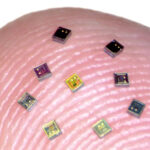Quantum sensors measure minute changes in electric and magnetic fields as well as motion and the measurements are made at the atomic level. At this scale, information from individual atoms instead of from huge collections of atoms allows quantum sensors to make exponentially more accurate, more thorough, more efficient, and more productive measurements. Using the smallest amounts of energy and matter, quantum sensors can detect and measure the smallest changes in time, gravity, temperature, pressure, rotation, acceleration, and frequency as well as magnetic and electric fields.
Unlike quantum computing which has been discussed for years but is not available for public use, quantum sensing has been available for several decades in products such as magnetic resonance imaging (MRI) machines. Similarly, microwave atomic clocks and superconducting quantum interference devices (SQUIDs), have used quantum sensors for decades as well. The next generation of quantum sensing is just emerging. It includes gravity sensors, nitrogen-vacancy (NV) sensors, and other innovations. Next-generation applications fall into at least eight categories and differ regarding maturity levels and market potential.
Applications for quantum sensors. (Image: McKinsey)
Applications, where an alternative technology does not exist, will receive the most competitive efforts. However, quantum sensors that can provide higher sensitivity than current sensors at a price that is comparable to or less than the existing approach will also be commercially attractive. Technologies used for the next generation of quantum sensing include neutral atoms, trapped ions, photonics, spin qubits, superconducting circuits, and elementary particles.
In the research environment, quantum sensors can measure the magnetic fields produced by the brain to diagnose neurological disorders. Types of quantum sensors and their potential applications in medicine and more include:
Thermometers that measure temperature with high precision and accuracy by using atoms or ions can find applications in areas such as materials science, medical diagnostics, and food safety.
Chemical sensors that detect various chemicals with high sensitivity and specificity can be used in environmental monitoring, medical diagnostics, and food safety.
Imaging sensors that use the properties of photons or atoms to create high-resolution images of objects or materials can find applications for medical imaging, materials science, and surveillance.
Atomic clocks that use the highly stable and predictable oscillations of atoms in materials such as cesium or rubidium atoms to measure time with extreme accuracy are being applied to GPS navigation and scientific research.
Magnetometers that use the properties of atoms or ions to measure magnetic fields can find applications in geology, medical diagnostics, and materials science.
Gravitometers that measure gravitational fields can be used for geophysics and navigation purposes.
Interferometers that use the interference patterns of photons to measure length or distance can be useful for metrology, microscopy, and precision engineering.
In medicine, quantum sensors are being used to develop new diagnostic tools for a variety of medical applications and in biomedical research for:
- Recording brain activity with wearable sensor helmets
- Neuronal circuits and rapid clinical testing with magnetometry of single neurons
- Cell development and endogenous heat generation
- Metabolomics studies
 (Image: Cerca Magnetics Limited)
(Image: Cerca Magnetics Limited)
For example, an optically pumped magnetometer (OPM)-based magnetoencephalography (MEG) can detect vector magnetic fields and unlike SQUIDs currently used in MEGs, they do not require cryogenic operation. Ongoing miniaturization efforts for OPMs have enabled prototype OPM-MEGs to be built and are paving the way toward real-world applications.
References
https://www.baesystems.com/en-us/definition/what-is-quantum-sensing#:~:text=is%20Quantum%20Sensing%3F-,What%20is%20Quantum%20Sensing%3F,collected%20at%20the%20atomic%20level.
https://www.defenseone.com/ideas/2022/06/quantum-sensorsunlike-quantum-computersare-already-here/368634/
https://www.mckinsey.com/industries/industrials-and-electronics/our-insights/shaping-the-long-race-in-quantum-communication-and-quantum-sensing
https://research.aimultiple.com/quantum-sensors/
https://www.nature.com/articles/s42254-023-00558-3
https://www.cercamagnetics.com/cerca-opm-meg


